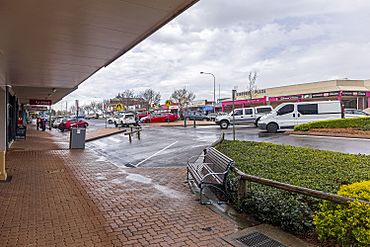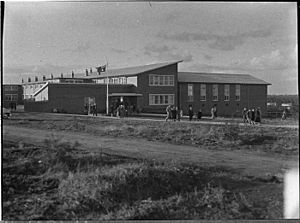Kurri Kurri, New South Wales facts for kids
Quick facts for kids Kurri KurriCity of Cessnock, New South Wales |
|||||||||||||||
|---|---|---|---|---|---|---|---|---|---|---|---|---|---|---|---|

Lang Street in Kurri Kurri
|
|||||||||||||||
| • Density | 1,106.7/km2 (2,866/sq mi) | ||||||||||||||
| Established | 1902 | ||||||||||||||
| Postcode(s) | 2327 | ||||||||||||||
| Elevation | 40 m (131 ft) | ||||||||||||||
| Area | 5.1 km2 (2.0 sq mi) | ||||||||||||||
| Time zone | AEST (UTC+10) | ||||||||||||||
| • Summer (DST) | AEDT (UTC+11) | ||||||||||||||
| Location | |||||||||||||||
| LGA(s) | City of Cessnock | ||||||||||||||
| Region | Hunter | ||||||||||||||
| County | Northumberland | ||||||||||||||
| Parish | Heddon | ||||||||||||||
| State electorate(s) | Cessnock | ||||||||||||||
| Federal Division(s) | Paterson | ||||||||||||||
|
|||||||||||||||
Kurri Kurri is a small town in the Hunter Region of New South Wales, Australia. It is part of the Cessnock local government area. In 2021, about 6,174 people lived in Kurri Kurri.
Kurri Kurri is the biggest town in a group of nearby towns. These include Stanford Merthyr, Pelaw Main, Weston, Abermain, and Heddon Greta. This larger area is sometimes called Kurri Kurri - Abermain.
Contents
History of Kurri Kurri
Kurri Kurri was started in 1902. It was built to support the coal mines nearby, like Stanford Merthyr and Pelaw Main. The name "Kurri Kurri" might mean "the very first" in the Awabakal language.
It was the first town in Australia that was completely planned before any buildings went up. A local group called the Progress Committee helped clear streets and set up services. The fire station and hospital were built by local people using money they raised themselves.
There isn't much history of Aboriginal people living right in this area. However, a small group visited the edge of the town before most of it was built. The first European to own land here was Benjamin Blackburn.
The Kurri Kurri Hotel was built in 1904. It's a large building with verandas and fancy ironwork. Many small miners' cottages were also built around this time.
Who Lives in Kurri Kurri?
In 2021, there were 6,174 people living in Kurri Kurri. This was a small increase from 6,044 people in 2016.
- About 11.5% of the people were Aboriginal and Torres Strait Islander.
- Most people (88.5%) were born in Australia. The next biggest group (1.6%) was born in England.
- Almost everyone (91.9%) spoke only English at home.
- When asked about religion, 43.3% said they had no religion. Other common answers were Anglican (18.7%) and Catholic (17.8%).
What People Do for Work
Coal Mining History
Coal mining in the South Maitland area began in 1891. This happened after a government expert found a lot of coal there in 1886. More mines opened in the early 1900s. These new mines became more important than older ones in Newcastle.
Sadly, there were some accidents. In 1905, six miners died at the Stanford Merthyr Colliery. There is a monument in the Kurri Kurri cemetery to remember them.
Richmond Main Colliery, near Kurri Kurri, was once the biggest coal producer in the state. It could dig up 3,400 tons of coal every day! It also had a very deep shaft to reach two different coal layers.
Over time, the coal industry slowed down. The Stanford Merthyr Colliery closed in 1957. Pelaw Main closed in 1962, and Richmond Main closed in 1967. The power station at Richmond Main Colliery kept working for a while. It provided electricity for Kurri Kurri until the area connected to the main power grid.
Aluminium Smelting
The Kurri Kurri aluminium smelter made aluminium from 1969 to 2012. It could produce up to 180,000 tons of aluminium each year.
Railways in Kurri Kurri
Kurri Kurri used to have passenger train stations. One was at Stanford Merthyr, and another was at North Kurri Kurri. The station at Stanford Merthyr was renamed Kurri Kurri Station in 1922.
Later, part of the railway line closed because the ground sank. So, the North Kurri Kurri station became the main Kurri Kurri station. Passenger trains no longer run on these lines. However, the railway line was still used for carrying coal until 2020. A new bridge was built to move the railway line for the Hunter Expressway.
Fun Events and Community Spirit
Tidy Towns
In 1988, Kurri Kurri started a "Tidy Town Committee." They worked to make the town look great. They were very successful! In 1993, Kurri Kurri was named the best town in New South Wales. It was also a finalist for the best town in Australia.
This success led to a new group called "Towns with Heart."
Mulletfest
Mulletfest is a fun event that started in Kurri Kurri. It celebrates the mullet haircut and other parts of bogan culture, like pub rock music. People from all over Australia come to enjoy this unique festival.
Nostalgia Festival
Every year, Kurri Kurri hosts a Nostalgia Festival. It's inspired by the 1950s and 1960s. You can see rock 'n' roll dancing, cool hot rods, and old bikes.
Schools and Learning
Primary Schools
- Kurri Kurri Public School
- Kurri Kurri Infants School
- The Holy Spirit Primary School
- Stanford Merthyr Infants School
- Pelaw Main Public School
- Weston Public School
- Abermain Public School
Secondary Schools
- Kurri Kurri High School
Colleges
- Hunter Institute of TAFE Kurri Kurri Campus
Local Art
Kurri Kurri is famous for its art! There are over 55 murals painted around the town. These murals show the history of the area and recent events.
Sports in Kurri Kurri
Many great sports stars have come from Kurri Kurri. Andrew Johns, a famous rugby league player, grew up here. He is considered one of the best players ever. Kurri Kurri has also produced more international rugby league players than any other country town in Australia.
Kurri Kurri is home to the Loxford Park Speedway. This is a 320-meter track for motorcycle speedway racing. It hosts many important races, including the Australian Solo Speedway Championship. There's also a smaller track for younger riders.
Important Places
Kurri Kurri has some places that are listed for their history. One important site is the Richmond Main Colliery, part of the South Maitland Coalfields.
Famous People from Kurri Kurri
- Ken Booth – a teacher, sportsman, and politician.
- Bob Bower – a rugby league player.
- Stan Callaghan – a rugby league player.
- Jim Comerford – a union leader, writer, and miner.
- Brad Dubberley – a coach for wheelchair rugby.
- Luke Ford – a writer.
- Peter Foster – a politician.
- Bill Hamilton – a rugby league player.
- Paul Harragon – a rugby league player.
- Mona Hessing – an artist who worked with fibers and weaving.
- Jemma House – a soccer player.
- Mark Hughes – a rugby league player.
- George Hunter – a rugby league player.
- Bert James – a national politician.
- Richard Johnson – a soccer player.
- Cliff Kelly – a rugby league player.
- Percy Lennard – a soccer player.
- Ernest Llewellyn – a violinist and violist.
- Eddie Lumsden – a rugby league player.
- Jack Lumsden – a rugby league player.
- Jeff Masterman – a rugby league player.
- Greg McLaren – a poet.
- George Neilly – a state politician.
- Sandy Pearson – an Australian Army Major General.
- Melody Pool – a country and folk musician.
- Chad Reed – an international motocross and supercross racer.
- Kayla Romaniuk – a rugby league player.
- John Sattler – a rugby league player.
- Richard Saunders – an actor, skeptic, writer, and podcaster.
- Adam Shields – a speedway rider.
- Gary Sullivan – a rugby league player.
- Meryl Swanson – a politician.
- Reegan Tanner – a rugby league player.
- Rohan Tungate – a speedway rider.
- Noel White – a rugby league player.



